FEATURES|THEMES|Philosophy and Buddhist Studies
A General Overview of the 17th IABS Congress in Vienna (18–23 August 2014)
Buddhistdoor Global | 2014-10-17 |
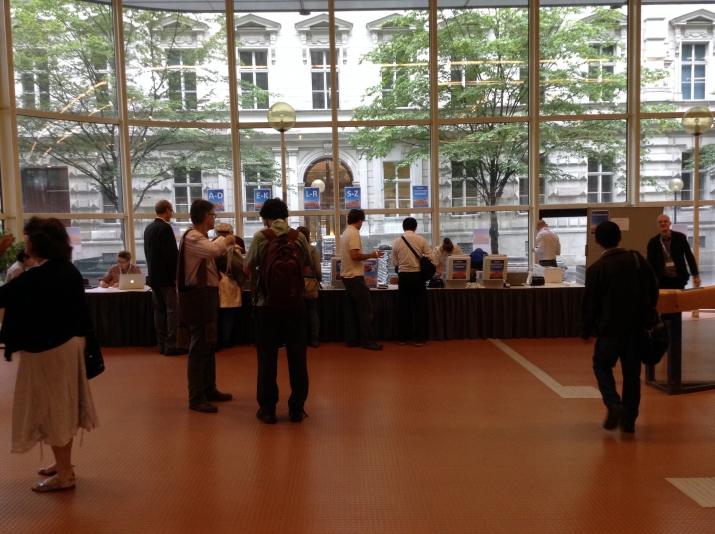 Participants registering and receiving the program from reception
Participants registering and receiving the program from receptionOn the way to Vienna for the 17th Congress of the International Association of Buddhist Studies (IABS) in the early morning of 18 August, the good memories of the 16th Congress at Dharma Drum Mountain (DDM) in Taipei automatically came to mind. It was my first visit to the historic city, with its strong background in art and music. As a postgraduate student, I was excited about the trip firstly because it presented a great opportunity to listen to the latest research on diverse topics in Buddhist Studies. More importantly, it was a valuable chance to meet world-renowned scholars and young researchers, to make new friends and catch up with old ones.
In the afternoon of 18 August, the first day of the six-day event, nearly 400 participants gathered for the opening session at the Audimax, a large lecture theatre at the University of Vienna, the congress venue. First, the representatives of the organizing team, including Professor Susanne Weigelin-Schwiedrzik (vice-rector of the University of Vienna), Professor Christina Scherrer-Schaub (president of the IABS), and Professor Klaus-Dieter Mathes (chair of the IABS Planning Committee) offered welcome addresses to the participants, and then Professor Ernst Steinkellner gave a keynote speech on “Dharmakirti’s Method for Ascertaining Causality and its alleged failure to solve the induction problem,” in which he argued for a new interpretation of Dharmakirti's translated statement for this method, thereby solving the problem for Dharmakirti's context and purposes. In the evening, the organizers had arranged a reception in the garden of the main building. Unsurprisingly, I met my teachers and fellow scholars from the UK and saw familiar faces from Hong Kong and Taiwan, but I also came across some European friends whom I had not seen since the last congress three years earlier.
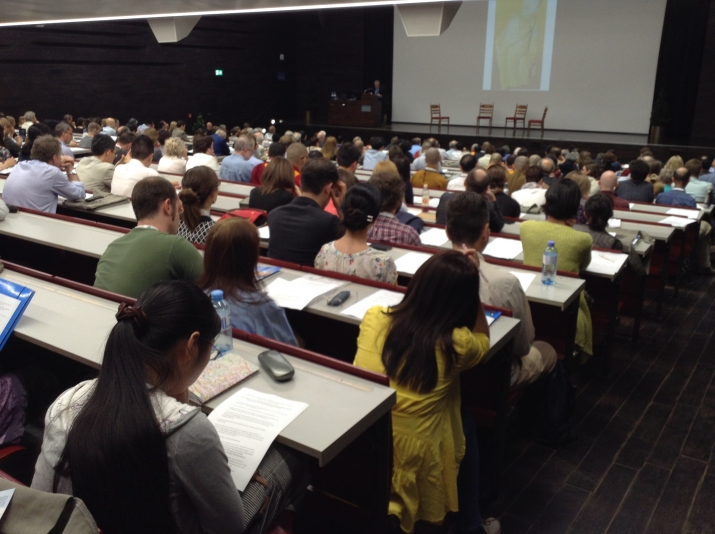 Professor Ernst Steinkellner giving keynote speech on “Dharmakirti’s Method for Ascertaining Causality and its alleged failure to solve the induction problem”
Professor Ernst Steinkellner giving keynote speech on “Dharmakirti’s Method for Ascertaining Causality and its alleged failure to solve the induction problem”Background of the University of Vienna
The host of this congress, the University of Vienna, was founded by Duke Rudolf IV (1339–65), and is one of the oldest universities in Europe—it will celebrate its 650th anniversary in 2015. Indeed, the philological basis for Buddhist Studies also has a long history in Vienna. Since Anton Boller started teaching Sanskrit at the university in 1845, the academic tradition has been continued by his successors, such as Friedrich Müller in the past century. With the advantages of the Austrian education system, the University of Vienna has established a firm place in Indian and Tibetan Buddhist Studies, with experts on subjects such as epistemology, logic, Madhyamaka, Mahamudra, and Tantra.
Academic Program
The academic program formally took place from 19–23 August at Juridicum, the Law School building of the university. There were over 400 active presenters overall, in 35 panels and 25 sections. While the panels were organized by individual conveners under various themes and the panel members invited in June 2012, the sections were arranged by the conference planning committee, with abstract submission after June 2013. As Professor Klaus-Dieter Mathes mentioned in his invitation letter, “Notwithstanding the fact that the increasing number of panels reflects the growing interest in specific fields, such proliferation jeopardizes the original spirit of the IABS Congress.” He stressed that the purpose of the conference was to demonstrate the wide variety of individual research, to promote collaboration, and to publicize new findings within all fields of research, creating opportunities for open discussion. Therefore, unlike last time at DDM, each participant was restricted to presenting a single paper of 20 minutes, with 10 minutes for discussion at the end. It had also been suggested to limit the number of panels to 20; however, this proved too great a restriction.
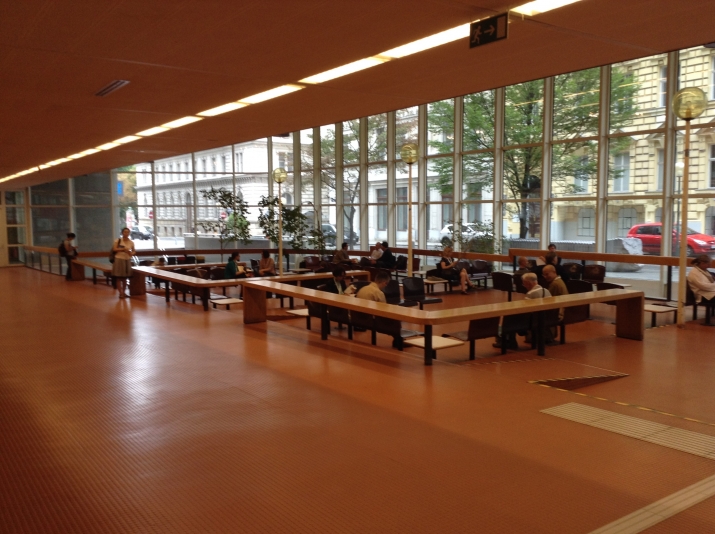 Common area on the ground floor: a wonderful place for participants to sit down, check emails, and rest
Common area on the ground floor: a wonderful place for participants to sit down, check emails, and restAmong the panels, there were numerous attractive topics, ranging from textual and philosophical to historical and ethnographical research. I was personally drawn to such presentations as “Arguing with Meditation,” “Buddhism on the Silk Road,” “Plants and Foods in East Asian Cultures,” “Buddhist Rhetoric,” “Creating Transnational Buddhist Networks Through International Travel,” and “The Mountain of Five Plateaus.” As a student in Anthropology, I made sure not to miss “Towards an Anthropology of Buddhism,” which might have been the first panel of its kind at an IABS Congress.
The topics of the sections seemed more commonplace; nonetheless, all paper abstracts were reviewed by the congress planning committee before acceptance. I was also attracted to many sections, among them “Gender in Buddhism,” “Buddhism and Society,” “Buddhism and Its Relation to Other Religions,” and “Buddhist Art and Architecture.” Certainly I could not miss “Contemporary Buddhism,” the section I chaired and in which I presented my own paper, “Becoming lay meditation teachers in contemporary Chinese Societies: cases in Hong Kong and Taiwan.”
Due to the large number of participants, there were often some 10–13 panels or sections arranged over a morning or afternoon. Hence, one very difficult and regrettable problem was having to choose between clashing presentations. Some classrooms filled up quickly, and there was not enough space for everyone to have a seat, or sometimes even to get in. For example, during the panel “Meditative and Soteriological Developments of the ‘Immeasurables’,” around 20 people had to stand as the title had attracted so much interest. Perhaps one of the most crowded panels was “Arguing with Meditation.” A few minutes into Professor Rupert Gethin’s talk, the chair observed that there were too many people standing both inside and outside the 50-seat classroom, and decided to move the whole panel to a 300-seat lecture theatre.
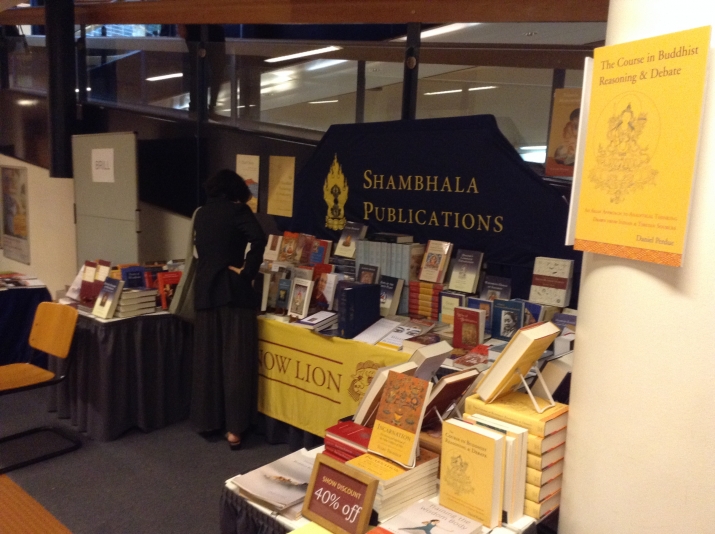 Shambhala Publications exhibition
Shambhala Publications exhibitionLike many participants, I ran between classrooms during the very short breaks in a rush to attend the papers I had prioritized. It was very disappointing to discover, just when we arrived at a classroom, that a particular presentation had been cancelled due to the absence of the presenter, such as “Buddhist Music in the Shingon Schools” and “An Unprecedented Analysis of Painting” in the “Buddhist Art and Architecture” section. Even more disappointing was the fact that I missed some presentations that had been moved earlier due to the sudden cancellation of the previous one. While in some cases I had overestimated a paper’s significance and level of interest, I attended quite a few papers that were much more intriguing and “entertaining” than I could have guessed from their titles. One such paper was “The Buddhism and Travels of Trebitsch Lincoln,” in which Veronika Máthé introduced a pioneer Hungarian Buddhist who ordained as a monk in the Chinese Buddhist tradition during the highly unstable socio-political climate of the early 20th century.
Before he became a Buddhist monk, Trebitsch was supposed to have become a rabbi in Paks, but instead became an Anglican priest in Canada, an MP in Britain, and an international spy. Nevertheless, he successfully inspired numerous Europeans to take monastic ordination. In another presentation, “Neo-Zen and Buddhist Identity in Contemporary Northern Vietnam,” Alexander Soucy examined the recent popularity of Zen Buddhism in Vietnam based on his recent ethnographic fieldwork. He argued that the revival of Zen practice was related to the globalization of Buddhism and the emergence of a transnational intellectual elite, rather than to the content and benefits of Zen practice. Certainly, there were many other fascinating presentations that I was unable to attend.
Before he became a Buddhist monk, Trebitsch was supposed to have become a rabbi in Paks, but instead became an Anglican priest in Canada, an MP in Britain, and an international spy. Nevertheless, he successfully inspired numerous Europeans to take monastic ordination. In another presentation, “Neo-Zen and Buddhist Identity in Contemporary Northern Vietnam,” Alexander Soucy examined the recent popularity of Zen Buddhism in Vietnam based on his recent ethnographic fieldwork. He argued that the revival of Zen practice was related to the globalization of Buddhism and the emergence of a transnational intellectual elite, rather than to the content and benefits of Zen practice. Certainly, there were many other fascinating presentations that I was unable to attend.
As a participant, overall I appreciated that the organizers had done their best to arrange similar panels or sections in the same classrooms. As a presenter, I appreciated that the technical arrangements and support were adequate; moreover, the technical staff actively approached us to check whether or not we needed help. The coffee breaks were appropriately scheduled, with one in the morning and one in the afternoon. However, there was still never enough time to chat with new and old friends, argue with “academic enemies,” discuss further collaborations, or purchase the highly discounted books from the exhibiting publishers.
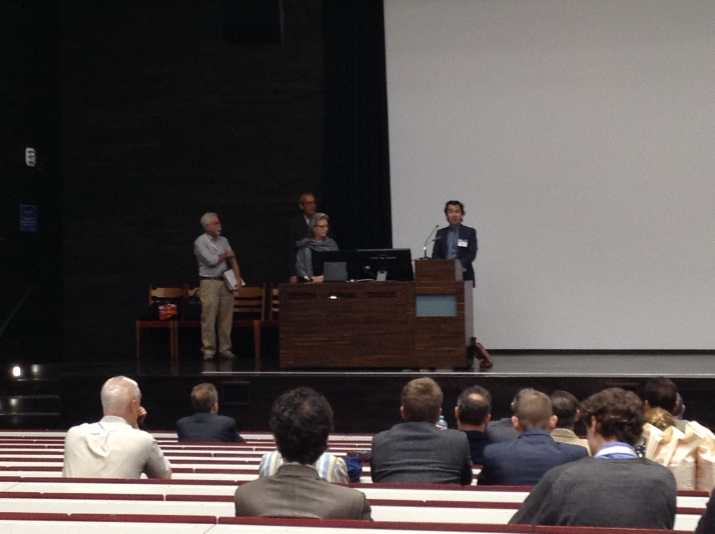 Christoph Emmrich on stage after IABS president Professor Christina Scherrer-Schaub announces that the University of Toronto will host the next IABS Congress in 2017
Christoph Emmrich on stage after IABS president Professor Christina Scherrer-Schaub announces that the University of Toronto will host the next IABS Congress in 2017Exhibitions, Project Presentations, and Excursions
Apart from the formal academic program, the organizers had scheduled various other academic and cultural activities, including exhibitions, project presentations, and excursions. All the exhibitions were arranged on the first basement level of the building, and there were quite a few familiar publishers in Buddhist Studies, including Cambridge University Press, Equinox Publishing Ltd., Shambhala Publications, and Wisdom Publications. The Austrian Academy of Sciences Press and the Vienna Studies in Tibetology and Buddhism had also been invited to exhibit, and the American Council of Learned Societies (ACLS) and The Robert H. N. Ho Family Foundation had a booth at the congress as well (see the interview with Professor Pauline Yu, president of the ACLS, in this issue). A few project presentations had been arranged in the evening, among them “Indo-Tibetan Lexical Resource”—a review of useful digital resources—“Buddhist Sanskrit Literature,” “The Pali Canon,” and “Indian Philosophical Texts.” There were also some excursions in the afternoon on 21 August, including a city walk, a tour of Vienna taking in Schönbrunn Palace, and a visit to the Vienna Residence Orchestra.
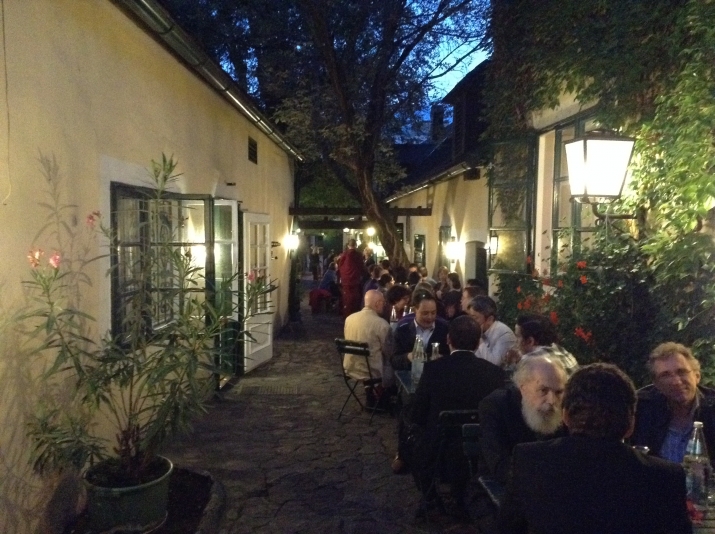 Farewell dinner: time to say goodbye to friends both new and old
Farewell dinner: time to say goodbye to friends both new and oldGeneral Meeting
While the number of attendees at the General Meeting in the late afternoon on 22 August was fewer than at the opening session, the atmosphere was supportive and serious. After recognizing the success of the congress, Professor Christina Scherrer-Schaub invited all the participants to stand up and observe silence for one minute as a tribute to the celebrated Indologist and Tibetologist Michael Hahn (1941–2014), who had recently passed away.
Just before the close of the General Meeting, IABS president Professor Christina Scherrer-Schaub announced that the next congress in 2017 would be hosted by the University of Toronto. On behalf of the university, Dr. Christoph Emmrich, a specialist in Nepalese and Burmese Buddhism, delightedly went to the stage, and confidently promised that he and his colleagues would start planning and preparing the conference facilities for the next congress immediately.
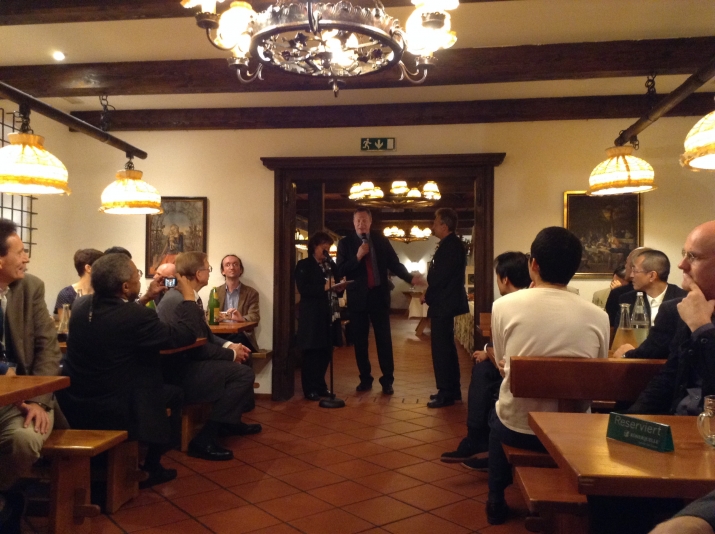 Farewell dinner at the Heuriger 10er Marie: Mr. Heinz Vettermann, a member of the local council and the general secretary of the Austrian Buddhist Society, giving a speech on behalf of the mayor
Farewell dinner at the Heuriger 10er Marie: Mr. Heinz Vettermann, a member of the local council and the general secretary of the Austrian Buddhist Society, giving a speech on behalf of the mayorFarewell Dinner
Following the General Meeting, all the guests were invited to attend a buffet dinner at a famous restaurant, Heuriger 10er Marie, by the mayor and governor of Vienna, Dr. Michael Häupl. Mr. Heinz Vettermann, a member of the local council and the general secretary of the Austrian Buddhist Society, gave a welcome speech on the mayor’s behalf. As well as demonstrating his honor and pride that Vienna had successfully hosted this year’s congress, Mr. Vettermann did not omit to disclose an important secret: “Indeed, I have practiced Zen for the past 17 years . . . ,” at which the guests applauded loudly. While Mr. Vettermann pointed out that drinks were free, Professor Klaus-Dieter Mathes immediately reminded the guests not to forget that there were panels the next day, which made us burst into laughter, before going to fill our very empty stomachs. For myself and many others, this enjoyable occasion was the perfect time to say goodbye to friends I probably would not see again until the next IABS congress in three years’ time.
Acknowledgements
I would like to express my gratitude to Dr. Alexander Schiller and Mr. Dennis Johnson for the information they kindly provided.
Back to IABS Special Issue Homepage

Categories:
Comments:
Share your thoughts:













